Let me just apologize up front for the egregious pun. It will all make sense in a minute.
I asked Wally the bed-and-breakfast owner what I should do today with no car, mediocre walking shoes and a student budget, since the castle is closed and, thanks to off-season, so are half the shops in Tintagel.
His suggestion was to catch the bus to Boscastle (a town famous for its pretty harbor and for the 2004 flood that demolished 500-year-old buildings and sent cars floating down its main street). This would make a good day trip in theory, until I walked to the bus shelter, realized I didn’t know which side of the street the bus would stop on because I didn’t know what direction Boscastle was in, gave up, and decided to pick a destination I could walk to.
Out of the Cornish coastal attractions I could name off the top of my head from my Tintagel research, I picked St. Nectan’s Glen, which I knew very little about except that it was pretty and involved a waterfall that flows through a hole in the rock.
The walk was somewhat hairy and frequently involved roads with no shoulder, much less sidewalk, although the brilliant blue sea and sky partially compensated for the danger to life and limb:
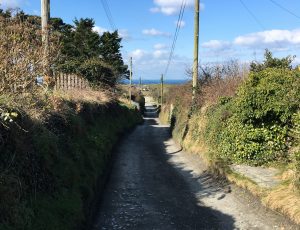
I arrived in Bossiney, closest hamlet to St. Nectan’s Glen, in one piece. Thank goodness for good signage, because although I knew from the photographs that St. Nectan’s Glen was forested, Bossiney is an island in a sea of sheep pastures with no obvious forest in sight.
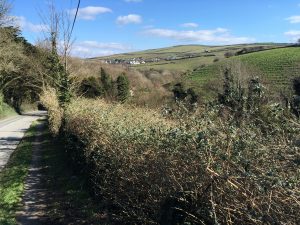
My excursion was nearly scuppered by a backhoe plugging the one-lane access road with less than an inch to spare between fender and stone wall, but the nice construction workers backed up enough for me to squeeze by. I followed the arrow signs through rural byways and down into a forested cleft nearly hidden from the town by a dip in the hills. In a forested gorge, a muddy trail wound through the trees and down to a shallow, crystal-clear creek.
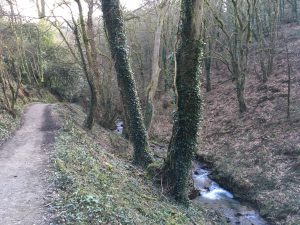
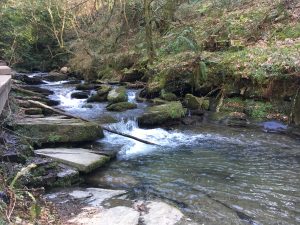
After perhaps half a mile of this, the path climbed partway back up the gorge walls to the visitor center and gift shop (the latter is filled with healing crystals, pentagram stones, faerie and dragon statuettes, Celtic blessing placards, and New Age Wiccan paraphernalia). I paid my three pounds admission, borrowed a pair of complimentary wellies from a shed full of them, and proceeded down lush stone stairs:
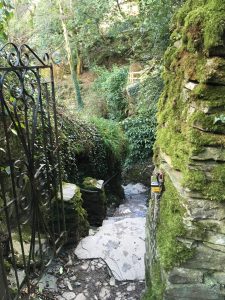
At the bottom, I finally understood what the wellies were for: there’s no trail, and to reach the waterfall you must wade upstream through three or four inches of creek. (Luckily it’s not slippery and the current is slow.)

The brightly colored blurry thing that you can’t see very well on the right side of this panorama is a tree branch with shreds of ribbon left as pagan blessings. Around the flooded clearing, there are rock stacks, Celtic plaques, carved pebbles, and other offerings left by practitioners of various New Age religions. Perhaps the eeriest is this log, which looks, in some indefinable way, wrong.
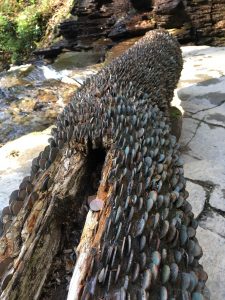
Up close, you can see that the growths are in fact oxidized coins of all different currencies embedded in the dead wood:
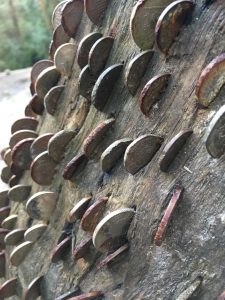
Around the other corner, tucked into a steep-sided gorge, is St. Nectan’s Kieve:
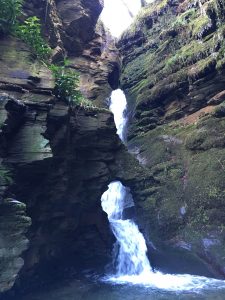
(I’ve left that photo at full resolution, despite the storage space it hogs, so you can see it in its full glory.)
Pictures don’t really do justice to the scale of the gorge walls, which rise about forty feet overhead and resemble something out of Indiana Jones, or at the very least, out of a primeval enchanted forest:
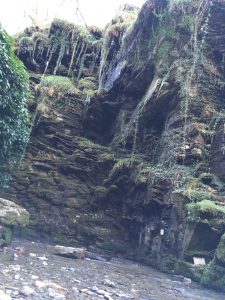
…And if you want to know how cold it was standing ankle-deep in this creek with the spray beading my rain jacket, here is a close-up on some of the moss growing from the rock. Note: Those are not columns of water; those are ice.
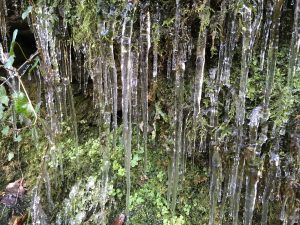
Kate goes hiking?!!!! What?!